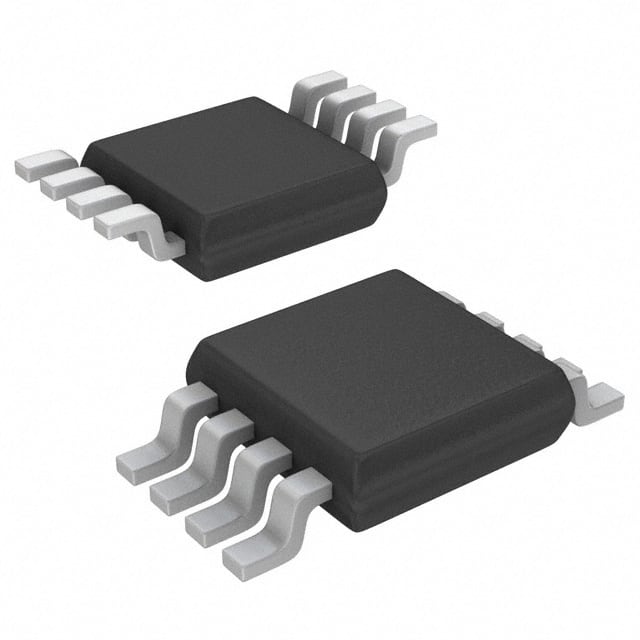X9313WMIZT1
Product Overview
- Category: Integrated Circuit (IC)
- Use: Digital Potentiometer
- Characteristics:
- Low power consumption
- High resolution
- Non-volatile memory
- Package: SOT-23-8
- Essence: X9313WMIZT1 is a digital potentiometer IC used for electronic circuit adjustments.
- Packaging/Quantity: Available in tape and reel packaging, with 3000 units per reel.
Specifications
- Resolution: 256 taps
- Supply Voltage: 2.7V to 5.5V
- Temperature Range: -40°C to +85°C
- End-to-End Resistance: 10kΩ
- Interface: Serial (SPI)
- Non-volatile Memory: Stores wiper position during power-off
Detailed Pin Configuration
The X9313WMIZT1 IC has the following pin configuration:
- VCC: Power supply voltage input
- H: High terminal of the resistor network
- W: Wiper terminal of the resistor network
- L: Low terminal of the resistor network
- CS: Chip select input for SPI communication
- SCK: Serial clock input for SPI communication
- SI: Serial data input for SPI communication
- SO: Serial data output for SPI communication
Functional Features
- Digital Potentiometer: Allows adjustment of resistance digitally through serial communication.
- Non-volatile Memory: Retains the wiper position even when power is turned off.
- High Resolution: Provides 256 taps for precise adjustment.
- Low Power Consumption: Operates efficiently with low power requirements.
Advantages and Disadvantages
Advantages: - Easy digital adjustment of resistance - Non-volatile memory ensures settings are retained - High resolution allows precise adjustments - Low power consumption for energy-efficient operation
Disadvantages: - Limited end-to-end resistance of 10kΩ - Requires SPI interface for communication
Working Principles
The X9313WMIZT1 digital potentiometer operates by utilizing a resistor network and a wiper terminal. The resistance between the high (H) and low (L) terminals can be adjusted digitally using the serial clock (SCK), chip select (CS), serial data input (SI), and serial data output (SO) pins. The wiper terminal (W) determines the output resistance based on its position along the resistor network.
Detailed Application Field Plans
The X9313WMIZT1 digital potentiometer finds applications in various electronic circuits that require adjustable resistance. Some potential application fields include:
- Audio Equipment: Volume control, tone adjustment, and equalization circuits.
- Industrial Control Systems: Calibration and fine-tuning of sensors and actuators.
- Test and Measurement Instruments: Precise resistance adjustments for accurate readings.
- Communication Systems: Signal conditioning and impedance matching circuits.
- Automotive Electronics: Control modules, climate control systems, and audio systems.
Detailed and Complete Alternative Models
- MCP4131: Digital Potentiometer IC with similar specifications and package options.
- AD8403: Digital Potentiometer IC with higher resolution and wider temperature range.
- MAX5481: Digital Potentiometer IC with integrated EEPROM for non-volatile memory.
These alternative models offer similar functionality and can be considered as alternatives to the X9313WMIZT1.
Word count: 389 words
Lista 10 Vanliga frågor och svar relaterade till tillämpningen av X9313WMIZT1 i tekniska lösningar
Sure! Here are 10 common questions and answers related to the application of X9313WMIZT1 in technical solutions:
Q1: What is X9313WMIZT1? A1: X9313WMIZT1 is a digital potentiometer IC (integrated circuit) that can be used to digitally control resistance in various electronic circuits.
Q2: What is the operating voltage range of X9313WMIZT1? A2: The operating voltage range of X9313WMIZT1 is typically between 2.7V and 5.5V.
Q3: How many resistive elements does X9313WMIZT1 have? A3: X9313WMIZT1 has three resistive elements, allowing for multiple independent potentiometers or rheostats.
Q4: What is the resolution of X9313WMIZT1? A4: The resolution of X9313WMIZT1 is 256 taps, meaning it can provide 256 discrete resistance values.
Q5: Can X9313WMIZT1 be used as a variable resistor? A5: Yes, X9313WMIZT1 can be used as a variable resistor by connecting one end terminal to the wiper terminal and using the other end terminal as the fixed reference point.
Q6: What is the typical power consumption of X9313WMIZT1? A6: The typical power consumption of X9313WMIZT1 is very low, usually around 1mW.
Q7: Is X9313WMIZT1 compatible with I2C communication? A7: Yes, X9313WMIZT1 uses the I2C (Inter-Integrated Circuit) protocol for communication with microcontrollers or other devices.
Q8: Can X9313WMIZT1 be used in audio applications? A8: Yes, X9313WMIZT1 can be used in audio applications for volume control, tone adjustment, or other audio signal processing.
Q9: What is the temperature range of X9313WMIZT1? A9: The temperature range of X9313WMIZT1 is typically between -40°C and +85°C.
Q10: Can X9313WMIZT1 be used in battery-powered devices? A10: Yes, X9313WMIZT1's low power consumption and wide operating voltage range make it suitable for battery-powered devices.
Please note that these answers are general and may vary depending on the specific datasheet and application requirements.


